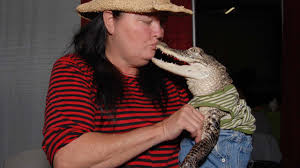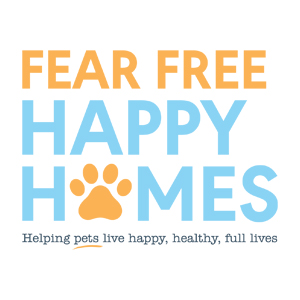Clothes-Wearing Pet Alligator
Mary Thorn & Rambo
 Mary Thorn is no regular pet guardian. Yes, she has dogs, but she also has a pet squirrel and an Alligator that she dresses in clothing. Mary just battled the State of Florida to keep "Rambo," a 6-foot gator that she considers part of the family. The calm and collected reptile also is a therapy animal for troubled children.
Mary Thorn is no regular pet guardian. Yes, she has dogs, but she also has a pet squirrel and an Alligator that she dresses in clothing. Mary just battled the State of Florida to keep "Rambo," a 6-foot gator that she considers part of the family. The calm and collected reptile also is a therapy animal for troubled children.
Rambo was four years old when he came to live with Mary, seven years ago. Mary originally got Rambo and five other alligators that were in a 10-gallon tank. They all lived in a dark closet for the first four years of their lives. They were never exposed to sunshine and all they could do in the cramped tank was to rock back and forth.
The tank full of Alligators was dropped off at the place where Mary was doing an alligator show. Mary had many previous years of experience with alligators before Rambo and says living in Florida you can find them in every ditch, every pond and every lake.
Normally alligators don't get sunburned, but after living their first four years in a dark closet, all six alligators were not able to be exposed to the sun at all. Two of the other five alligators actually died of sun exposure.
The law in Florida is that you have to have 2.5 acres to keep an alligator over four feet, and Mary doesn't have that amount of land. However, since Rambo is sun sensitive, the 2.5 acres wouldn't benefit him in the least. Mary provided a veterinarian letter to the State of Florida stating two of the other alligators died from sun exposure and that Rambo was allergic to the sun.
Now that Rambo can stay, he has his own bedroom not only with a regular bed and a pool, but a television and refrigerator as well.
 The plan wasn't originally to dress Rambo in clothing, but Mary needed to find a way to keep him from getting sunburned. She had some scraps lying around and one day decided to make an outfit for him. Now, if Rambo doesn't have his clothes on, he just mopes around the house until he gets dressed.
The plan wasn't originally to dress Rambo in clothing, but Mary needed to find a way to keep him from getting sunburned. She had some scraps lying around and one day decided to make an outfit for him. Now, if Rambo doesn't have his clothes on, he just mopes around the house until he gets dressed.
Rambo became a performer who was taught to sit on props and take pictures with people. Unfortunately part of the new condition in which Mary gets to keep Rambo no longer allows him to do public appearances. Mary doesn't agree with this, as she states Rambo has never had an aggressive moment in his life.
Rambo still gets many visitors and does therapy with children who will sit with him and tell him their problems and why they can't get along with people. Rambo will just sit there and listen to them.
Rambo also lives with five dogs, two opossums and a squirrel. Mary says when someone in her neighborhood finds an animal that has been injured; it ends up in her house. Everyone gets along and Mary states that Rambo acts like her five dogs.
In captivity, alligators can live 100 years and about 35 years in the wild. Mary doesn't recommend alligators as pets and would rather see them live in a natural habitat and not the way Rambo is forced to live.
See Rambo on Facebook
500 Of The Most Absurd And Horrifying Things That Happen In Nature!
Ezra Reid Ross - Nature is the Worst: 500 Reasons You'll Never Want To Go Outside Again
 E. Reid Ross will tell us about 500 of the most absurd and horrifying things that happen in nature. From murderous squirrels to farting fish, "E" uncovers and revels in some of Mother Nature's ugliest moments.
E. Reid Ross will tell us about 500 of the most absurd and horrifying things that happen in nature. From murderous squirrels to farting fish, "E" uncovers and revels in some of Mother Nature's ugliest moments.
So why is nature so bad? "E" tells us it depends on where you are and what you're involved in, but that there's plenty out there to be afraid of. You don't have to be an arachnophobia or afraid of the deep water to find a lot to be terrified of. As a result, "E" decided to compile 500 of these reasons.
Some of the top things you should be frightened of, according to "E," are plants and fungus. He tells us he could never have imagined that there was a type of thorn bush that could kill you if you just walk passed it. In New Zealand, if you go off the nature paths for 10 seconds, you could be quivering to a quick death just by brushing up against a stupid bush.
There are also plants that consume bugs and animals. While they are not growing legs and rampaging the countryside mauling livestock, it is more of a slow process. There is one plant that is even capable of eating sheep. It does this by trapping the sheep on purpose. When the sheep dies, the plant then soaks up the nutrients from the where the corpse lands.
 There is also a bacterium that specifically targets your eyeballs. It will actually work its way underneath your contact lens, and if left unchecked, will devour your eyeball.
There is also a bacterium that specifically targets your eyeballs. It will actually work its way underneath your contact lens, and if left unchecked, will devour your eyeball.
People living in Florida have to deal with alligators and crocodiles, and a recent discovery shows that crocodiles are actually able to shimmy up trees after their prey. They have also been known to set traps with their mouth. They put little sticks for nest building in the bottom of the their jaw, open wide, and wait for a bird to try and collect the sticks for their nest. When the bird lands, the alligator closes its mouth and catches them.
"E" also tells us about those cute little prairie dogs that are murderers! Of course they have to compete with other animals for land and food, but it is still hard to see them murder a baby squirrel while you're enjoying the scenery looking out over the vista at the Grand Tetons.
 You would be surprised that while herring fish are benign, they are also very vocal. However, most of the communication comes from the rear ends. They communicate via "farts." You've probably seen footage of them moving in a group that looks like it has been choreographed? Well, they don't bump into each other because they are communicating with their farts.
You would be surprised that while herring fish are benign, they are also very vocal. However, most of the communication comes from the rear ends. They communicate via "farts." You've probably seen footage of them moving in a group that looks like it has been choreographed? Well, they don't bump into each other because they are communicating with their farts.
So where does "E" get all of his information? He states he has been practicing for the last five years and writing articles on horrible nature since 2011. He also looks at zoological charts and wants to give a shout out to Carly Brooke at the Featured Creature, because she has been a fantastic source of information for him.
Ezra Reid Ross resides in Maryland, and is a columnist/editor at Cracked.com. He's no scientist, that's for sure, but with a background in military intelligence and law enforcement, he's not just the author this book needs, he's exactly the one it deserves.
Visit Publisher
 What's Your Vet-iquette - How to Be a Good Veterinary Client - Dr. Debbie
What's Your Vet-iquette - How to Be a Good Veterinary Client - Dr. Debbie
Sure you think your vet visits go off without a hitch, but do you know how to be a good veterinary client, the kind veterinarians rave about? Follow these suggestions to participate as a vital part of your pet's medical care, to ensure your pet gets the most efficient care, and to always be greeted with beaming smiles.
Be Prepared
Before you arrive at the office with a sick pet, know your pet's ins and outs. Without a pertinent history from you, your veterinarian may need more diagnostic tests to sleuth out the answer to the problem. That takes time and can cost you more in veterinary bills.
Expect the questions your vet is likely to ask you. Has your pet been eating? What types and brand of food do you feed him? Is there diarrhea or constipation?
Bring Evidence
Nothing is more useful to your veterinarian as seeing something with her own eyes. Bring evidence like stool samples, vomited material, and medications your pet is receiving. Has your pet chewed on some unusual plant in the backyard? By all means bring a sprig of that plant.
Document video on your smart phone. This can be immensely helpful to your veterinarian to witness behaviors that may be intermittent. I've been thankful when owners bring smart phone video of seizures, separation anxiety behaviors, and respiratory ailments.
Video eliminates misinterpretation by pet owners, and can permit a quick veterinary diagnosis. Vomiting and regurgitating may look similar, but are caused by different disorders. Pets strain to defecate with both diarrhea and constipation. Inspiratory wheezing, coughing, congestion and reverse sneezing are often described similarly by owners.
Trust Valid Resources
By all means do your research in advance of your veterinary visit. Know what questions to ask. But remember that the internet is abounding with both good and blazingly incorrect information, some based on opinions and conjecture without any sound medical basis. Pet owners who value Dr. Google's opinion over their veterinarian, who has examined their pet, could put their pet's health care in jeopardy.
Confine Your Pet
Make sure your pet is secure before entering the veterinary hospital. Don't underestimate the unpredictable things pets do in a noisy, crowded waiting room. Birds fly off shoulders landing in snack zone of nearby dogs. Dogs instigate fights, and cats flee the waiting veterinary staff's arms. Pay attention to where your pet is and don't allow your pet to approach other animals without the owner's consent. Some animals are there because they are sick, and could bite in unfamiliar surroundings.
Dogs should be on a secure leash. Flexi leashes are dangerous in the veterinary hospital allowing dogs to bolt quickly toward another dog, or to entangle limbs of humans or other animals in the waiting room. Cats and exotic pets should be secured in an appropriate pet carrier.
If you have a pet that has been or could be aggressive to veterinary staff…absolutely share that information before the visit starts. Veterinarians look out for the safety of people in their employment and appreciate a heads-up in advance to avoid potential staff injury.
 Optimize Your Face Time
Optimize Your Face Time
So now you are in the exam room with the doc, so make the most of it. Put the cell phone away, and by all means…don't waste time taking a phone call if medical staff is standing in front of you.
Avoid distractions that will limit your ability to communicate with your veterinarian. This might include a roomful of boisterous children or other pets. If possible, arrange child care or pet sitting so your sick pet gets prime attention and you don't miss any details of the visit.
Emergencies Happen
At the vet office, we recognize how valuable pet owner's time is and try to minimize the wait. But recognize that emergencies are unforeseen and create delays for other pet owners. Most folks understand that emergencies happen and are accommodating during situations as this.
But making a scene or outburst about your wait time, while the veterinary staff tends to a critical pet is just inconsiderate. Recognize that one day your pet could be in that same place and you would be appreciative that your pet's medical emergency was triaged ahead of the waiting routine appointments.
Don't Attack the Messenger
Emotions can run high when you have a sick or injured pet, but it isn't an excuse to be abusive to hospital staff. Obscene language and overly aggressive behavior doesn't help your pet get the care she needs, nor does it endear yourself to those people working hard for your pet's health.
Own Your Own Reality
Pet owners have the daunting responsibility for the health and well-being of pets in their care. That means accepting the level of veterinary care you can pursue, and recognizing choices if finances are limited. Pet insurance can help defer the cost of veterinary care, but there isn't government sponsored Obamacare for pets.
Don't blame your veterinarian for your pet's health maladies, or expect her to cover the costs of treatment. People in the veterinary field do what they do because they love animals, but they shouldn't be expected to take financial responsibility for everyone's pets. I once heard a veterinary colleague respond to an client's question, "Doc, why can't you just do my Sasha's surgery for free?" His response was, "Because my staff needs to get paid and my kids need shoes." Recognize that veterinary offices aren't lending institutions, but rather are small businesses with pressing bills, just as anyone.
Share Your Feedback
Share feedback with the hospital management about service excellence or shortcomings. Every hospital appreciates the opportunity to improve, or the chance to pat staff on the back.
Featured veterinarian known as "Dr. Debbie" on national pet radio program, Animal Radio. Ebook author of "Yorkshire Terriers: How to Be Your Dog's Best Friend"; "Pugs: How to Be Your Dog's Best Friend"; "Mini Schnauzers: How to Be Your Dog's Best Friend"; and "Shih Tzu: How to Be Your Dog's Best Friend."
Visit Website
5 Things Everyone Should Know About Seeing Eye Dogs
Robert Semrow, Listomania
 We just recently celebrated the birthday of the first school for Seeing Eye Dogs in America. Dorothy Eustis opened up the School on January 29, 1929. She had been contacted by a blind person named Morris Frank after his family read an article about the dog training she was doing in Germany for blind veterans of World War I. Their remarkable story, and what it has led to, has been an inspiration for many, including myself. So much so that when we created our Pet X Talks series, that was one of the first Pet X Talks we did, Thank you Kate Kelly.
We just recently celebrated the birthday of the first school for Seeing Eye Dogs in America. Dorothy Eustis opened up the School on January 29, 1929. She had been contacted by a blind person named Morris Frank after his family read an article about the dog training she was doing in Germany for blind veterans of World War I. Their remarkable story, and what it has led to, has been an inspiration for many, including myself. So much so that when we created our Pet X Talks series, that was one of the first Pet X Talks we did, Thank you Kate Kelly.
To celebrate the school's birthday, and the incredible amount of people they have impacted, I thought I would share 5 things everyone should know about Seeing Eye Dogs.
To begin with, it takes nearly 18 months of training to go from puppy to guide dog and not every dog that starts the program will become a certified Guide Dog. Some estimates are as many 20-percent of the trainees do not pass and become guide dogs, as they are not proficient enough in critical skills that are essential for the safety and well being of the Guide Dog and it's person.
When Morris Frank and his seeing eye dog Buddy the 1st walked across West Street in Manhattan, he kicked open the doors of acceptance and also possibilities. Remember back in 1928 Seeing Eye Dogs were not only non-existent but there were no laws that required they be allowed in places. Fortunately, Morris made it his mission to change minds and laws and today Seeing Eye dogs have laws that allow them access where typically only people could go.
 Three of the most popular breeds that are trained to be seeing eye dogs should be no surprise; Golden Retrievers, Labrador Retrievers and German Shepherds. These breeds are well know to be calm, fiercely loyal dogs who are extremely intelligent and calm under pressure. As important, they are great companions and loving dogs who are devoted to their human.
Three of the most popular breeds that are trained to be seeing eye dogs should be no surprise; Golden Retrievers, Labrador Retrievers and German Shepherds. These breeds are well know to be calm, fiercely loyal dogs who are extremely intelligent and calm under pressure. As important, they are great companions and loving dogs who are devoted to their human.
One of the more interesting things that a Seeing Eye dog is trained to do is to refuse a command if it is unsafe for the dog or the human. This is so important, especially at busy streets, when that human is putting absolute faith in the dog to guide both of them safely.
A typical career span for a Seeing Eye dog is 7-10 years. This might not seem like a long time, but when you add in the training time and the 24/7 vigilance, it's a lifetime. Most Seeing Eye dogs are retired to adoptive families so that a new Seeing Eye dog can work with the human without distraction.
Seeing Eye dogs, as well as most working dogs, are so inspiring by their selfless nature. They live to serve and care for those around them. When you think about all that they are tasked with, it is no wonder these dogs are often referred to as four-legged heroes.
Share your experiences with Seeing Eye dogs on our Animal Radio Facebook Page.
Visit Website
Animal Radio News - Lori Brooks
 Heart Disease Isn't Just In Humans
Heart Disease Isn't Just In Humans
When you hear the words heart disease, you think of humans, but it is a problem for animals too. Unlike most dogs with heart disease, many cats with heart disease show no symptoms: no cough, no lethargy and no decline in appetite. In the midst of a cardiac crisis, it's much like a human having a heart attack. These cats will have labored breathing, pale gums, become very weak, experience severe pain and may even have numbness in their limbs. According to a number of studies, 16-percent of all apparently healthy cats have heart disease. However, Maine Coons and Ragdolls have a genetic mutation they can inherit that predisposes them to heart disease.
 An Animal Was Harmed!
An Animal Was Harmed!
Did you see the video taken on the set of the movie A Dog's Purpose, which shows a trainer appearing to force a German Shepard into rough, turbulent water? As you can imagine, it has a lot of people questioning what the rules for animal safety are on film sets. Amblin Entertainment is defending its treatment of animals on movie sets, saying they, "Followed rigorous protocols to foster an ethical and safe environment for the animals." The statement adds that Hercules, the dog in the video, had several days to rehearse the stunt and when he became apprehensive on the day of shooting, the production team did not proceed with filming and that today, "Hercules is happy and healthy." The controversy sparked by the video has led the public to question exactly what it means when movies claim "No Animals Were Harmed" during their making. It begins with The American Humane Association's Film and Television Unit, which is responsible for providing protection for animals on a TV or movie set. To get the certification that "No Animals Were Harmed," a list of more than 500 guidelines must be followed while a Certified Animal Safety Rep, who has gone through extensive training, needs to be on site to oversee scenes involving animals. Then, the movie or TV shows gets the "No Animals Were Harmed" seal of approval in the credits after a final screening by the AHA and double-checking with the animal rep for confirmation. That's it. You think that would be enough, but in response to the video leaked from the set featuring the German Shepherd, the AHA has placed the representative responsible for overseeing the film on administrative leave and is bringing in a third party to investigate the events shown in the video. The group also says when Hercules the dog showed signs of resistance to jumping in the water; the scene should have been stopped. Finally, People Magazine did a story on this subject and a senior staff attorney with the Animal Legal Defense Fund, told them that while the AHA guidelines represent humane standards of care, overall its power is "mostly hollow" and limited in how it can really protect animals. The attorney said that is because there are no federal laws in place to protect animal actors. Instead, the animal cruelty laws of the state where the filming takes place control the legal protection of animals in film.
 Cat Gets Diploma to Highlight Fraud
Cat Gets Diploma to Highlight Fraud
There's a cat named Oreo C. Collins from Macon, Georgia, who successfully earned an online "High School Diploma" from Jefferson High School. Oreo's owner, Kelvin Collins, President and CEO of the Better Business Bureau of Central Georgia, admits he might have helped the cat take the test and write the life-experience essay required for graduation, but he said Oreo was on his lap the whole time. Oreo, with all his smartness, is highlighting what needs some improvement. Oreo actually got his diploma as a way to highlight fraud in online degree programs. A real GED diploma requires someone to take the test in-person.
UK Is Banning Film Because of Animal Cruelty
The Scottish Activist Group Animal Concern is officially asking the four main cinema chains in the United Kingdom NOT to screen the now controversial film A Dog's Purpose, due for release in the UK in April. Footage has emerged showing one of the canine stars of the movie, a German Shepherd named Hercules, being cruelly treated after he failed to dive into a tank of turbulent water while filming. His handler eventually throws the obviously terrified Hercules into the water. Hercules quickly gets into difficulty in the water and when the current pulls him under, the director yells, "CUT!" while panicking safety divers move in to find him. The leaked footage does not show Hercules being rescued, but the makers of the film have said he was pulled to safety.
 Junk Food Raccoons Relocated
Junk Food Raccoons Relocated
A colony of raccoons that became famous for devouring junk food behind a Louisiana grocery store has been successfully relocated. They were known as the "Winn Dixie Colony" after the grocery store where they regularly devoured sweet snacks and food left out for feral cats. The story goes that nearby residents had begun feeding the raccoons sweet treats to prevent them from eating the food left out for the feral cats to eat. When the cat caretakers fed them the junk food, it kept the raccoons in a separate area, so the cats could eat at the same time. Animal Control officers monitored the situation and reported seeing more than 30 raccoons that were at least 30-to-40 pounds each!
Kentucky Only State to Where Bestiality Is Not a Crime
After Ohio passed legislation recently making bestiality a felony, Kentucky was one of the few remaining states left where it is not criminal to have sex with an animal. Now, the state House in Kentucky has introduced Bill 143, which would ban the sexual assault of a pet dog or cat, but it doesn't address any concern for other animals in order to avoid antagonizing hunters and farmers.
 Dog Earns Record For World's Longest Tail
Dog Earns Record For World's Longest Tail
A dog in Belgium earned himself a spot in the Guinness Book of World Records for having the world's longest tail. An Irish wolfhound named Keon gets the honor. His tail measures 30.2 inches long from the top of the bone to the tip, without including his hair, according to the Guinness World Records. Keon's tail bests the previous record holder for "Longest tail on a dog" by 1.7 inches.

NEWS UPDATE brought to you by Fear Free. "Take the 'pet' out of 'petrified'" and get pets back for veterinary visits by promoting considerate approach and gentle control techniques used in calming environments.
 Listen to the entire Podcast of this show (#896)
Listen to the entire Podcast of this show (#896)



 The plan wasn't originally to dress Rambo in clothing, but Mary needed to find a way to keep him from getting sunburned. She had some scraps lying around and one day decided to make an outfit for him. Now, if Rambo doesn't have his clothes on, he just mopes around the house until he gets dressed.
The plan wasn't originally to dress Rambo in clothing, but Mary needed to find a way to keep him from getting sunburned. She had some scraps lying around and one day decided to make an outfit for him. Now, if Rambo doesn't have his clothes on, he just mopes around the house until he gets dressed. E. Reid Ross will tell us about 500 of the most absurd and horrifying things that happen in nature. From murderous squirrels to farting fish, "E" uncovers and revels in some of Mother Nature's ugliest moments.
E. Reid Ross will tell us about 500 of the most absurd and horrifying things that happen in nature. From murderous squirrels to farting fish, "E" uncovers and revels in some of Mother Nature's ugliest moments.  There is also a bacterium that specifically targets your eyeballs. It will actually work its way underneath your contact lens, and if left unchecked, will devour your eyeball.
There is also a bacterium that specifically targets your eyeballs. It will actually work its way underneath your contact lens, and if left unchecked, will devour your eyeball. You would be surprised that while herring fish are benign, they are also very vocal. However, most of the communication comes from the rear ends. They communicate via "farts." You've probably seen footage of them moving in a group that looks like it has been choreographed? Well, they don't bump into each other because they are communicating with their farts.
You would be surprised that while herring fish are benign, they are also very vocal. However, most of the communication comes from the rear ends. They communicate via "farts." You've probably seen footage of them moving in a group that looks like it has been choreographed? Well, they don't bump into each other because they are communicating with their farts. What's Your Vet-iquette - How to Be a Good Veterinary Client -
What's Your Vet-iquette - How to Be a Good Veterinary Client -  Optimize Your Face Time
Optimize Your Face Time
 We just recently celebrated the birthday of the first school for Seeing Eye Dogs in America. Dorothy Eustis opened up the School on January 29, 1929. She had been contacted by a blind person named Morris Frank after his family read an article about the dog training she was doing in Germany for blind veterans of World War I. Their remarkable story, and what it has led to, has been an inspiration for many, including myself. So much so that when we created our Pet X Talks series, that was one of the first Pet X Talks we did, Thank you Kate Kelly.
We just recently celebrated the birthday of the first school for Seeing Eye Dogs in America. Dorothy Eustis opened up the School on January 29, 1929. She had been contacted by a blind person named Morris Frank after his family read an article about the dog training she was doing in Germany for blind veterans of World War I. Their remarkable story, and what it has led to, has been an inspiration for many, including myself. So much so that when we created our Pet X Talks series, that was one of the first Pet X Talks we did, Thank you Kate Kelly.
 Three of the most popular breeds that are trained to be seeing eye dogs should be no surprise; Golden Retrievers, Labrador Retrievers and German Shepherds. These breeds are well know to be calm, fiercely loyal dogs who are extremely intelligent and calm under pressure. As important, they are great companions and loving dogs who are devoted to their human.
Three of the most popular breeds that are trained to be seeing eye dogs should be no surprise; Golden Retrievers, Labrador Retrievers and German Shepherds. These breeds are well know to be calm, fiercely loyal dogs who are extremely intelligent and calm under pressure. As important, they are great companions and loving dogs who are devoted to their human.
 Heart Disease Isn't Just In Humans
Heart Disease Isn't Just In Humans
 An Animal Was Harmed!
An Animal Was Harmed!
 Cat Gets Diploma to Highlight Fraud
Cat Gets Diploma to Highlight Fraud
 Junk Food Raccoons Relocated
Junk Food Raccoons Relocated
 Dog Earns Record For World's Longest Tail
Dog Earns Record For World's Longest Tail
